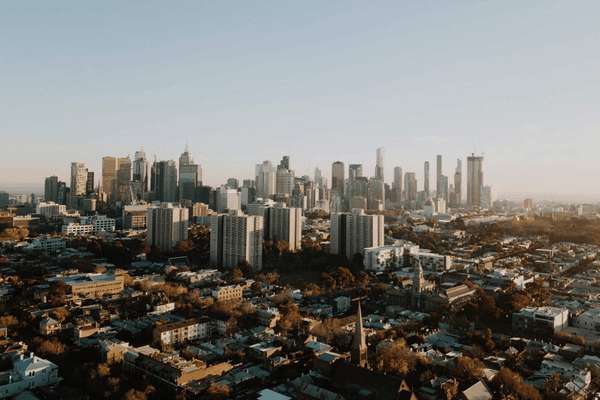
Share
Discover why Melbourne property prices are leading Australia's growth in 2025. Expert analysis on rate cuts, affordability, and opportunities for first-home buyers
While property investors flocked to Brisbane penthouses and Perth suburbs throughout 2024, the smartest money was quietly positioning itself in Melbourne. The Victorian capital, dismissed by many as yesterday’s news after years of sluggish performance, has just delivered a knockout punch that nobody saw coming.
Inner Melbourne house prices have rocketed 3.6% since February, while unit prices have soared an impressive 5.9% - outpacing every other local property market across Australia. This isn’t just another statistical blip; it’s the start of Melbourne’s comeback story, and the early chapters are already rewriting everything we thought we knew about Australia’s property landscape.
For first-home buyers and property watchers who’ve been sitting on the sidelines, Melbourne property prices 2025 trends offer something that seemed impossible just months ago: genuine affordability combined with genuine growth. The Reserve Bank’s February interest rate cut has unleashed pent-up demand, creating a perfect storm of opportunity that savvy buyers are already capitalising on.
The numbers behind Melbourne’s remarkable turnaround
Melbourne’s recent performance reads like a property fairy tale. PropTrack data reveals that inner Melbourne’s 3.6% house price growth and 5.9% unit price surge since February represents the strongest quarterly performance of any Australian property market during this period. These aren’t modest gains - they’re game-changing numbers that signal a fundamental shift.
Here’s what makes these figures extraordinary: Melbourne had been the nation’s property underdog for nearly five years. Between March 2020 and April 2025, dwelling values grew just 16.2% compared to a whopping 43.3% across combined capital cities. This prolonged slump left Melbourne’s median dwelling value at $781,000, making it surprisingly affordable as the second cheapest major capital after Perth ($779,000).
Melbourne’s median house price now sits at approximately $917,000, having jumped 0.4% in February alone. While annual figures still show negative growth, the momentum shift is undeniable. Sales volumes have surged 9.8% year-on-year, proving buyers are rushing back to a market they’d abandoned.
The unit market tells an even more compelling story. With median unit prices around $572,491, apartments offer first-home buyers a realistic pathway into Melbourne property ownership. Units are rising faster than houses as buyers scramble for affordable entry points, creating opportunities that seemed impossible during the boom years.
Take St Kilda East, where units average $575,000 - a fraction of what similar lifestyle locations cost in Sydney. Or explore areas like Keilor East, where the median house price of $1.045 million still delivers value when compared to equivalent suburbs in other capitals.
How interest rate cuts transformed buyer sentiment
February’s RBA cash rate cut from 4.1% to 3.85% didn’t just change borrowing costs - it rewired buyer psychology across Melbourne. This quarter-percentage-point reduction slashed monthly repayments by roughly $90 on a typical $600,000 mortgage, but the psychological impact proved far more valuable than the dollar savings.
REA Group’s research revealed that 40% of Victorian buyers now believe it’s a good time to purchase property - the highest confidence level of any Australian state. This dramatic sentiment shift explains why Melbourne auction clearance rates have bounced from a dismal 61-63% in November 2024 to above 70% in early 2025.
The market is pricing in multiple rate cuts throughout 2025, with major banks forecasting the cash rate falling to between 3.1% and 3.35% by year’s end. Westpac economists predict four cuts could reduce monthly mortgage repayments by $349 on a $600,000 loan - enough to significantly expand borrowing capacity for Melbourne first home buyer affordability seekers.
This expectations game is crucial for understanding Melbourne’s momentum. Buyers aren’t just responding to current rates; they’re positioning themselves for a falling rate environment that could deliver substantial savings over the life of their mortgages.
Melbourne’s affordability advantage in the national context
Melbourne’s secret weapon in 2025 is something it hasn’t possessed for over a decade: genuine affordability relative to other major cities. After years of underperformance, Melbourne now offers exceptional value in a national property landscape where million-dollar medians have become commonplace.
The numbers tell the story: Melbourne is now cheaper than Brisbane, Adelaide, and tracking to undercut Perth. REA Group senior economist Anne Flaherty highlights this dramatic reversal, noting that buyers are recognising value that simply doesn’t exist elsewhere.
Melbourne’s dwelling value to income ratio sits around 7:1, meaning a household earning the median income needs seven times their annual earnings to buy the median-priced property. While this remains challenging, it compares favourably with markets where ratios exceed 8:1 or 9:1.
For first-home buyers, this affordability gap represents opportunity. A young professional couple earning $120,000 combined can realistically target properties in Melbourne’s middle-ring suburbs, accessing amenities and lifestyle benefits that would cost significantly more in Sydney or the Gold Coast.
Interstate migration patterns are already responding to these price differentials. Workers who can maintain Melbourne salaries while accessing more affordable housing are driving renewed demand across the metropolitan area.
Competition from other high-performing markets
While Melbourne’s growth impresses, it’s worth understanding how other Australian markets are performing to gauge relative opportunities and risks.
Townsville leads the national charge with predictions of 25-30% growth in 2025. The Queensland city’s median house price of $520,000 could reach $650,000 or more, driven by massive infrastructure spending and mining investments. However, Townsville’s economy remains concentrated in specific industries, creating higher volatility risks.
The Gold Coast represents a different trajectory entirely. After experiencing a staggering 79% price surge since early 2020, median house prices now exceed $1.2 million. While lifestyle appeal remains strong, affordability has evaporated for most first-home buyers.
Darwin offers compelling rental yields around 6% for houses, making it attractive for investors seeking income returns. The Northern Territory capital combines affordable entry prices with strong rental demand, though smaller market size limits liquidity.
These comparisons highlight Melbourne’s unique position. Unlike Townsville’s concentrated economy or Darwin’s limited scale, Melbourne combines growth potential with economic diversity. Unlike the Gold Coast’s lifestyle premium, Melbourne maintains accessibility for average earners.
First-home buyer opportunities in the new landscape
Current Melbourne market conditions are creating a rare alignment of factors favouring first-home buyers. Multiple trends are converging to improve opportunities for those ready to enter the property market.
Investor competition has dramatically reduced. Ray White chief economist Nerida Conisbee reports that many investors have exited the market due to minimal capital gains, rental reforms, and additional land taxes in Victoria. This investor exodus particularly benefits first-home buyers, as both groups typically target similar affordable properties.
Negotiating power has shifted towards buyers in many segments. Sellers facing slower markets are more willing to negotiate on price or offer incentives, creating opportunities that were scarce during intense competition periods.
Melbourne’s unit market offers exceptional first home buyer affordability Melbourne opportunities. Recent data shows apartments outperforming houses as buyers seek accessible entry points. Areas like Spring Gully in Bendigo offer $650,000 median house prices with regional growth potential, while Glen Waverley provides family-friendly amenities near top schools and universities.
Government support is expanding significantly. From January 2026, virtually all first-home buyers can enter the market with just 5% deposits through taxpayer-backed guarantees. This initiative removes the traditional 20% deposit barrier that has delayed countless buyers.
Victorian-specific incentives include stamp duty reductions for off-the-plan properties until October 2025, making new developments more attractive. The government has also identified 50 activity centres where streamlined planning processes will fast-track housing developments near public transport.
Market fundamentals supporting Melbourne’s recovery
Beyond interest rate impacts, solid fundamentals underpin Melbourne’s property market recovery, suggesting recent growth represents sustainable momentum rather than temporary speculation.
Population growth continues driving housing demand. Victoria added 184,000 residents in the year to March 2024 - the nation’s highest growth rate. Greater Melbourne’s population has reached 5.8 million, with international arrivals creating significant rental market pressure.
Supply constraints are tightening market conditions. New home completions have hit 10-year lows, with dwelling approvals running 15% below decade averages. The shortage is most acute in affordable housing segments, creating upward price pressure across all market levels.
Infrastructure investment supports long-term growth prospects. The Melbourne Airport Link project will benefit areas like Keilor East, while broader transport and development spending improves connectivity and amenities throughout the metropolitan area.
Melbourne’s economic base remains robust and diversified. The city’s universities, cultural institutions, and business services continue attracting workers and residents. While pandemic lockdowns created temporary challenges, economic recovery is now supporting renewed property market confidence.
Construction industry constraints are also supporting prices. Labour shortages and material costs are limiting new supply just as demand recovers, creating a supply-demand imbalance that favours existing property owners.
Expert predictions and market outlook for 2025
Industry experts are cautiously optimistic about Melbourne’s prospects for the remainder of 2025, though forecasts vary based on interest rate assumptions and economic conditions.
Domain Group projects Melbourne house prices growing 3-5% in 2025, with units experiencing slightly lower growth rates. This represents a significant improvement from recent negative growth and aligns with expectations of continued rate cuts throughout the year.
Major bank forecasts are more conservative, with NAB predicting 1.2% growth for Victorian capital dwellings and Westpac forecasting 1.0% gains. However, these estimates may prove conservative if interest rates fall faster than expected.
Historical analysis suggests property prices often outperform initial forecasts once rate-cutting cycles begin. Bank of Queensland data indicates 10-15% price rises over two years represent reasonable expectations when monetary policy shifts to accommodate growth.
Market fragmentation will likely continue, with different segments performing based on affordability constraints and buyer demographics. Premium inner-ring suburbs may benefit from improved affluent buyer confidence, while affordable segments could gain from first-home buyer activity and government incentives.
The key variable remains the pace and extent of further rate cuts. Multiple reductions throughout 2025 could accelerate Melbourne’s recovery beyond current forecasts, while slower monetary easing might moderate growth expectations.
What this means for different types of buyers
Melbourne’s evolving market creates distinct opportunities and challenges for different buyer types, reflecting changing economic conditions and market dynamics.
First-home buyers
First-home buyers face a potentially narrow window of opportunity. Current conditions combining improved affordability, reduced investor competition, and government incentives may not persist indefinitely. Buyers should focus on areas where they can afford repayments comfortably, acknowledging that interest rates will fluctuate over mortgage terms.
Strategic suburbs to watch include St Kilda East for units, Altona North for family homes, and outer areas like Spring Gully for maximum affordability. The key is buying within genuine capacity rather than stretching to maximum borrowing limits.
Property investors
Property investors must weigh Melbourne’s capital growth potential against rental yields and carrying costs. While recent price growth encourages optimism, rental yields remain relatively low compared to markets like Darwin. Focus areas should include suburbs with strong rental demand and infrastructure development prospects.
Downsizers
Downsizers may find current conditions ideal for transitioning to smaller properties. Melbourne’s strong unit market performance provides opportunities to realise gains from larger family homes while securing well-located apartments. Reduced stamp duty for off-the-plan properties until October 2025 adds incentive for new development purchases.
Interstate buyers
Interstate buyers should carefully evaluate Melbourne’s value proposition against their local markets. While Melbourne offers relative affordability compared to Sydney, buyers from Brisbane or Perth may find Melbourne more expensive than home markets. However, Melbourne’s economic diversity and long-term prospects may justify higher entry costs.
Melbourne’s property future
Melbourne’s emergence as Australia’s fastest-growing property market since February’s interest rate cut marks a profound shift in the national property landscape. After years of underperformance relative to other capitals, the Victorian capital is demonstrating the resilience and fundamental appeal that justified its position as Australia’s second-largest city.
The convergence of improved affordability, renewed buyer confidence, and robust economic fundamentals creates compelling opportunities for those positioned to recognise and act on current conditions. First-home buyers, in particular, benefit from reduced investor competition and expanded government support measures that provide genuine pathways to property ownership.
Melbourne property prices 2025 trends suggest sustainable growth rather than speculative bubbles. The market offers steady, measured appreciation supported by genuine economic and demographic drivers rather than artificial stimulation.
As interest rates continue falling throughout 2025, Melbourne’s property market appears ideally positioned to benefit from improved borrowing conditions and recovering buyer sentiment. The question isn’t whether Melbourne will continue growing, but whether potential buyers are prepared to act while conditions remain favourable.
In property markets, timing often determines the difference between opportunity and regret. Melbourne’s current resurgence offers a powerful reminder that even the most challenging markets can present unexpected possibilities for those ready to recognise value and act decisively when conditions align.
Further questions
How much have Melbourne property prices grown since the RBA rate cut in February 2025?
Why is Melbourne now considered more affordable than other Australian capital cities?
What government incentives are available for first-home buyers in Melbourne in 2025?
Which Melbourne suburbs offer the best value for first-home buyers right now?
How do Melbourne's current property market conditions compare with other Australian cities like Townsville and the Gold Coast?
This is general information only and is subject to change at any given time. Your complete financial situation will need to be assessed before acceptance of any proposal or product.





